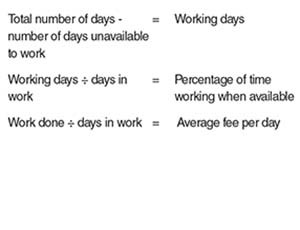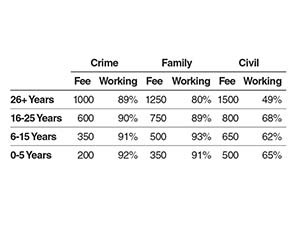*/

A masterclass (with worked examples) on how to implement and manage fair work allocation. By Scott Baldwin
All barristers, pupils and staff need to understand your chambers’ approach to fair allocation of work (FAW), and the best way to achieve this is to create a formal policy document. It is essential that you work collaboratively with your clerks in this process; they will be at the front line of implementing your approach to FAW and you need to harness their experience of managing incoming enquiries.
The policy needs to set out:
The bulk of managing unassigned work will fall on your clerks but there are times when barristers will have significant input into who is instructed.
There should be clarity on the process that clerks should follow when offering counsel for unassigned work. This need not be overly prescriptive; clerks need a great deal of autonomy in order to be able to function effectively. The process must acknowledge a commitment to actively seek to avoid discrimination of any sort; this should provide a clear framework for your clerks.
Some specifics will need to be addressed. How many alternatives should they provide to a client? If 30 barristers are free, do you really want clerks to offer all of them? Probably not, so be clear; three to five is a good range. Set out the circumstances in which you are happy to trust the clerks’ judgement on who to offer. Practice development of individual barristers will doubtless play a large part in how work is allocated; reference this in the process.
When barristers are directing where work should go (this can be common where a leader chooses a junior or vice versa) there should be clear guidance for those who find themselves in this position.
The two main providers of software to barristers’ chambers have equality and diversity (E&D) monitoring built in. This will allow you to produce a range of financial information broken down by key protected characteristics. The data relies on the vast majority of members of chambers completing diversity questionnaires. Without the structure this provides, you may find it difficult to make proper comparisons.
Both software companies also offer a service which tracks how work is allocated, called opportunity bookings. When clerks provide a client with a list of barristers for unassigned work they record who was offered, on what basis, who the client chose, and why they made that choice.
Opportunity bookings can be a powerful tool in getting to the root cause of an issue but won’t solve all your problems. It can create significantly more work for your clerks as part of the booking process. It can, however, be a great tool for practice development. The decision to use opportunity bookings is one you need to take after careful consideration of the pros and cons.
To get started, you will need to know what the average fee per day is for each area of work grouped by seniority/level of expertise. You can then track for each barrister on a monthly basis the number of days they are in work, not available to work, and free or not working where they were otherwise available.
From this, we extract these key pieces of data:

Take this data on average fee per day and percentage of time working and break it down for different areas of work and different levels of expertise. This creates a framework which can be used as the basis for your review.
Below is a very simple structure using the calculations and data set out above:

You can then easily compare an individual barrister against these averages and identify where you may have an issue. This works regardless of whether the barrister has a mixed practice because you can break down their total work done into the different areas.
The working figures are your guide to whether work is being distributed fairly; the fee figures tell you whether the value of that work is also equitable. It is important to consider both. Two barristers may have an equal number of days in court, but Barrister A may be getting more access to higher paid work than Barrister B.
Whenever a problem occurs, it is important that you do not jump to conclusions. Be open and honest when seeking to resolve it. You must ensure that a record is kept of the following series of events:
The first consideration is whether there is a problem. You may find that there is a good reason why a barrister who is in court less often and/or earning less than the average. This is common, for example, where someone is taking a phased return to work and is limiting the type of work they do and the number of days they are available to work.
If there is a problem, you should have a clear escalation plan. It is often the case that the root cause is miscommunication. For example, if clerks are not aware that a barrister wishes to do more of one type of work then problems will occur and that barrister may feel they are being overlooked. A team meeting can often fix simpler issues. Where the problem is more serious, it may well be necessary to involve an equality and diversity (E&D) officer, head of chambers etc.
Most problems, however, can be avoided through regular practice review meetings. Barristers and clerks working together are far more effective at developing practice areas and resolving problems than they are working on their own.
Keeping an accurate record of what happened is key even if, after investigation, there was a clear explanation for any potential inequalities found.
If your chambers does not have a system in place to track and review FAW then it is worth considering Rule C110 of the BSB Handbook:
If you are a self-employed barrister, the affairs of your chambers are conducted in a manner which is fair and equitable for all members of chambers, pupils and/or employees (as appropriate). This includes, but is not limited to, the fair distribution of work opportunities among pupils and members of chambers.
Barristers cannot be absolved of responsibilities by relying on head of chambers, management committee or E&D officer. You have a duty to ensure chambers has systems in place to ensure fair allocation of work. If your set does not have a system in place then you must ensure something is done. That may mean lobbying your head of chambers, management committee or E&D officer or volunteering to help create a system.
There is no one size fits all system which will work for all chambers. The data collection and comparison system described above is effective where the bulk of your work is court based. Where the bulk is paperwork, you need different metrics.
In conclusion, this is not a tick box exercise; it should be a fundamental part of how your chambers operates and it needs a collaborative approach which includes clerks and barristers in order for it to work.

All barristers, pupils and staff need to understand your chambers’ approach to fair allocation of work (FAW), and the best way to achieve this is to create a formal policy document. It is essential that you work collaboratively with your clerks in this process; they will be at the front line of implementing your approach to FAW and you need to harness their experience of managing incoming enquiries.
The policy needs to set out:
The bulk of managing unassigned work will fall on your clerks but there are times when barristers will have significant input into who is instructed.
There should be clarity on the process that clerks should follow when offering counsel for unassigned work. This need not be overly prescriptive; clerks need a great deal of autonomy in order to be able to function effectively. The process must acknowledge a commitment to actively seek to avoid discrimination of any sort; this should provide a clear framework for your clerks.
Some specifics will need to be addressed. How many alternatives should they provide to a client? If 30 barristers are free, do you really want clerks to offer all of them? Probably not, so be clear; three to five is a good range. Set out the circumstances in which you are happy to trust the clerks’ judgement on who to offer. Practice development of individual barristers will doubtless play a large part in how work is allocated; reference this in the process.
When barristers are directing where work should go (this can be common where a leader chooses a junior or vice versa) there should be clear guidance for those who find themselves in this position.
The two main providers of software to barristers’ chambers have equality and diversity (E&D) monitoring built in. This will allow you to produce a range of financial information broken down by key protected characteristics. The data relies on the vast majority of members of chambers completing diversity questionnaires. Without the structure this provides, you may find it difficult to make proper comparisons.
Both software companies also offer a service which tracks how work is allocated, called opportunity bookings. When clerks provide a client with a list of barristers for unassigned work they record who was offered, on what basis, who the client chose, and why they made that choice.
Opportunity bookings can be a powerful tool in getting to the root cause of an issue but won’t solve all your problems. It can create significantly more work for your clerks as part of the booking process. It can, however, be a great tool for practice development. The decision to use opportunity bookings is one you need to take after careful consideration of the pros and cons.
To get started, you will need to know what the average fee per day is for each area of work grouped by seniority/level of expertise. You can then track for each barrister on a monthly basis the number of days they are in work, not available to work, and free or not working where they were otherwise available.
From this, we extract these key pieces of data:

Take this data on average fee per day and percentage of time working and break it down for different areas of work and different levels of expertise. This creates a framework which can be used as the basis for your review.
Below is a very simple structure using the calculations and data set out above:

You can then easily compare an individual barrister against these averages and identify where you may have an issue. This works regardless of whether the barrister has a mixed practice because you can break down their total work done into the different areas.
The working figures are your guide to whether work is being distributed fairly; the fee figures tell you whether the value of that work is also equitable. It is important to consider both. Two barristers may have an equal number of days in court, but Barrister A may be getting more access to higher paid work than Barrister B.
Whenever a problem occurs, it is important that you do not jump to conclusions. Be open and honest when seeking to resolve it. You must ensure that a record is kept of the following series of events:
The first consideration is whether there is a problem. You may find that there is a good reason why a barrister who is in court less often and/or earning less than the average. This is common, for example, where someone is taking a phased return to work and is limiting the type of work they do and the number of days they are available to work.
If there is a problem, you should have a clear escalation plan. It is often the case that the root cause is miscommunication. For example, if clerks are not aware that a barrister wishes to do more of one type of work then problems will occur and that barrister may feel they are being overlooked. A team meeting can often fix simpler issues. Where the problem is more serious, it may well be necessary to involve an equality and diversity (E&D) officer, head of chambers etc.
Most problems, however, can be avoided through regular practice review meetings. Barristers and clerks working together are far more effective at developing practice areas and resolving problems than they are working on their own.
Keeping an accurate record of what happened is key even if, after investigation, there was a clear explanation for any potential inequalities found.
If your chambers does not have a system in place to track and review FAW then it is worth considering Rule C110 of the BSB Handbook:
If you are a self-employed barrister, the affairs of your chambers are conducted in a manner which is fair and equitable for all members of chambers, pupils and/or employees (as appropriate). This includes, but is not limited to, the fair distribution of work opportunities among pupils and members of chambers.
Barristers cannot be absolved of responsibilities by relying on head of chambers, management committee or E&D officer. You have a duty to ensure chambers has systems in place to ensure fair allocation of work. If your set does not have a system in place then you must ensure something is done. That may mean lobbying your head of chambers, management committee or E&D officer or volunteering to help create a system.
There is no one size fits all system which will work for all chambers. The data collection and comparison system described above is effective where the bulk of your work is court based. Where the bulk is paperwork, you need different metrics.
In conclusion, this is not a tick box exercise; it should be a fundamental part of how your chambers operates and it needs a collaborative approach which includes clerks and barristers in order for it to work.
A masterclass (with worked examples) on how to implement and manage fair work allocation. By Scott Baldwin


Chair of the Bar reflects on 2025
AlphaBiolabs has donated £500 to The Christie Charity through its Giving Back initiative, helping to support cancer care, treatment and research across Greater Manchester, Cheshire and further afield
Q&A with criminal barrister Nick Murphy, who moved to New Park Court Chambers on the North Eastern Circuit in search of a better work-life balance
Revolt Cycling in Holborn, London’s first sustainable fitness studio, invites barristers to join the revolution – turning pedal power into clean energy
Rachel Davenport, Co-founder and Director at AlphaBiolabs, reflects on how the company’s Giving Back ethos continues to make a difference to communities across the UK
By Marie Law, Director of Toxicology at AlphaBiolabs
Are you ready for the new way to do tax returns? David Southern KC explains the biggest change since HMRC launched self-assessment more than 30 years ago... and its impact on the Bar
Professor Dominic Regan and Seán Jones KC present their best buys for this holiday season
Marking one year since a Bar disciplinary tribunal dismissed all charges against her, Dr Charlotte Proudman discusses the experience, her formative years and next steps. Interview by Anthony Inglese CB
Little has changed since Burns v Burns . Cohabiting couples deserve better than to be left on the blasted heath with the existing witch’s brew for another four decades, argues Christopher Stirling
Pointillism, radical politics and social conscience. Review by Stephen Cragg KC